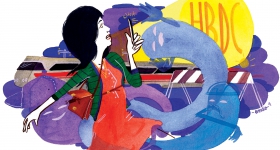This picture is from a Thanksgiving Day meal at the Rohwer Relocation Camp’s staff mess-hall in McGehee, AR, 1942. Though accurate population statistics were hard to come by, due to the constant movement in the internment of Japanese Americans, Rohwer is estimated to have held about 8,475 people at its peak. Almost 30 percent of those were children.
I haven’t been able to find very much about relocation center Thanksgivings, but Rohwer’s final report states that: “Services at the churches, a good dinner with turkey or chicken, a championship football gams [sic], a social dance, and private parties made this day memorable.”
I’m sorry to say that I’m not an expert on Asian American history (yet), so it’s rather curious to me that the National Archives’ only two photos of Thanksgiving in Rohwer do not attempt to depict the Japanese American internees in the kinds of "fun," celebratory settings good for PR. Dozens of photos from the same Thanksgiving at the Gila Relocation Center in Rivers, AZ, show its residents building parade floats, holding pageants, and getting down and dirty on the dance floor, 1940s-style. However, the picture above shows a setting where the Japanese American internees seem to be the event’s serving staff, rather than its attendees.
So what really happened at Rohwer? Were they less concerned with the image they were supposed to present than the directors at Gila? Tom Parker, the photographer, took other pictures on that day at Rohwer, but they are largely of the internees working in offices or taking classes. Is this dinner photo, then, a more accurate representation of a relocation center Thanksgiving -- or is this, too, propaganda? Does anyone know?
As we prepare to sit down with our loved ones, take a look at this anonymous poem which was circulated around the Poston Relocation Center in La Paz County, Arizona. It’s called “That Damned Fence.”
They’ve sunk the posts deep into the ground We’re trapped like rats in a wired cage, We seek the softness of the midnight air, With nowhere to go and nothing to do, Imprisoned in here for a long, long time, Loyalty we know, and patriotism we feel, We all love life, and our country best,
They’ve strung out wires all the way around.
With machine gun nests just over there,
And sentries and soldiers everywhere.
To fret and fume with impotent rage;
Yonder whispers the lure of the night,
But that DAMNED FENCE assails our sight.
But that DAMNED FENCE in the floodlight glare
Awakens unrest in our nocturnal quest,
And mockingly laughs with vicious jest.
We feel terrible, lonesome, and blue:
That DAMNED FENCE is driving us crazy,
Destroying our youth and making us lazy.
We know we’re punished -- though we’ve committed no crime,
Our thoughts are gloomy and enthusiasm damp,
To be locked up in a concentration camp.
To sacrifice our utmost was our ideal,
To fight for our country, and die, perhaps;
But we’re here because we happen to be Japs.
Our misfortune to be here in the west,
To keep us penned behind that DAMNED FENCE,
Is someone’s notion of NATIONAL DEFENCE!
Sorry to end on a bit of a downer, but this poem really resonated with me and my notion of being thankful. The damned fence of the poem is gone, but new ones have taken its place. In addition to family, friends, and personal fortune, I think it’s important to remember and be thankful for the freedoms we have today, even as we’re fighting for more social justice and immigration reform.
Happy Thanksgiving, everyone.
Further reading:
War Relocation Camps in Arizona 1942-1946
Photo citation:
Still Picture Records Section, Special Media Archives Services Division (NWCS-S), National Archives at College Park, 8601 Adelphi Road, College Park, MD, 20740-6001.









Comments